SCROLL DOWN FOR THE OLDER ONES AND TRANSLATIONS TO OTHER LANGUAGES
Wind Turbine Recipe Book (Metric Edition)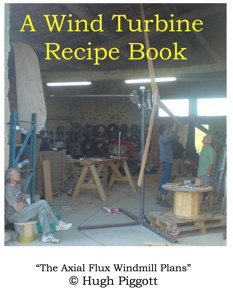
My most popular step-by-step guide
…more details.
This Metric edition uses 46x30x10mm magnets, and wire sizes are in mm. If you prefer to use inches and AWG then see “English Units” edition below.
Get the right edition for your local magnet and wire sources!
Old ebook 2010 Metric edition for Amazon Kindle ($5USD)
Buy the PDF using card payment.
Paper copies by post, use the Paypal buttons below to be sent the latest 2023 edition.
PLEASE NOTE THAT I CANNOT NOW SEND HARD COPY BY MAIL TO THE EU FROM HERE, SO please see this link and copies by mail from Jonathan in Austria. Or you can also buy from Ti’eole in France.
Choose UK or the world outside of the EU using the drop down menu.
Wind Turbine Recipe Book in inches
(North American English Units Edition)
See above for the metric units edition.
Get the right edition
for your local magnet and wire sources!
Available as an ebook from Smashwords
Paper copies by mail, use the Paypal button below to pay $20 USD, and be sent hard copy of the latest (2014) edition.
2F  Construction Manual
Construction Manual
my latest plans, for only one size (2 metre diameter)
using durable ferrite magnets, and simplified blade carving.
…..More details
Available as an ebook from Smashwords
To buy a copy by mail click the paypal button below, first choosing your location for shipping. Sorry but I can no longer ship this to EU countries due to Brexit.
VERY OLD DOCUMENTS ONLINE
Scrapyard Windpower Realities (classic) Ebook of 1992 publication
PMG construction manual 2001 (free pdf) free pdf download
My old book “Windpower Workshop” deals with a lot of the basic theory in a simple fashion. It is now out of print but you can find used copies online.
TRANSLATIONS OF THE RECIPE BOOK
FRANCAIS
La majeure partie de cet ouvrage provient du manuel de Hugh Piggott “A wind turbine recipe book” paru en 2008.
Pour cette nouvelle édition de 2014, la maquette du manuel a été entièrement revisitée, actualisée, illustrée et agrémentée de nouveaux visuels, avec des compléments sur l’installation électrique, la fabrication du mât ainsi que de nouvelles annexes.
http://www.tripalium.org/
Sie wollten schon immer mal eine Windturbine bauen? Ihr Zögling plagt Sie mit Fragen, wie das mit der Windkraft denn so genau geht? Die können Sie im nun ganz einfach beantworten; mit der Selbstbauanleitung für Kleinwindturbinen „Drei Flügel im Wind“ von GREEN STEP e.V. Mit dieser Anleitung können Sie mit einfachsten Materialien aus dem Baumarkt eine einfache funktionierende Windkraftanlage zur Stromversorgung bauen. Und wer weiß, vielleicht wird Ihr Zügling ja damit dann so berühmt wie William Kwamkamba – „Der Junge der den Wind einfing“ – er baute in Afrika eine Windturbine um das Haus seiner Eltern mit Strom zu versorgen.
Der Gewinn aus dem Verkauf des vorliegenden Werkes kommt den Projekten in Kamerun zu Gute. Das nächste große Projekt des Vereins in Kamerun ist der Bau einer erneuerbaren Energieschule in der junge Menschen im Bau von Kleinstwind- und Wasserkraftanlagen, verbesserten Kochern, Solartrocknern und Regenwasserzisternen und vielem mehr ausgebildet werden.
https://www.green-step.org/shop/drei-fluegel-im-wind
ESPAÑOLA
Contact 500rpm in Argentina for a Spanish translation.
Nederlandse
Het handboek “A wind turbine recipe boek” is nu ook in het Nederlands verschenen. Dit handboek is een praktische handleiding voor het zelfbouwen van een turbine. Er zijn een zestal variaties uitgewerkt beginnend bij een wiekdiameter van 120 cm tot een diameter van 420 cm. In de tabel zie je de geschatte opbrengsten bij verschillende gemiddelde windsnelheden
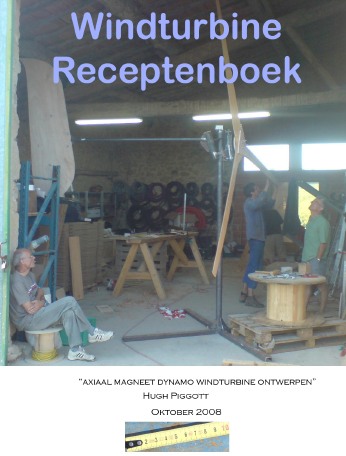
TRADUZIONE ITALIANA
di Antonio Cecere e Beatrice Paparella
“acecere” <[email protected]>
HUNGARIAN
CONTACT ME for a PDF edition in Hungarian.

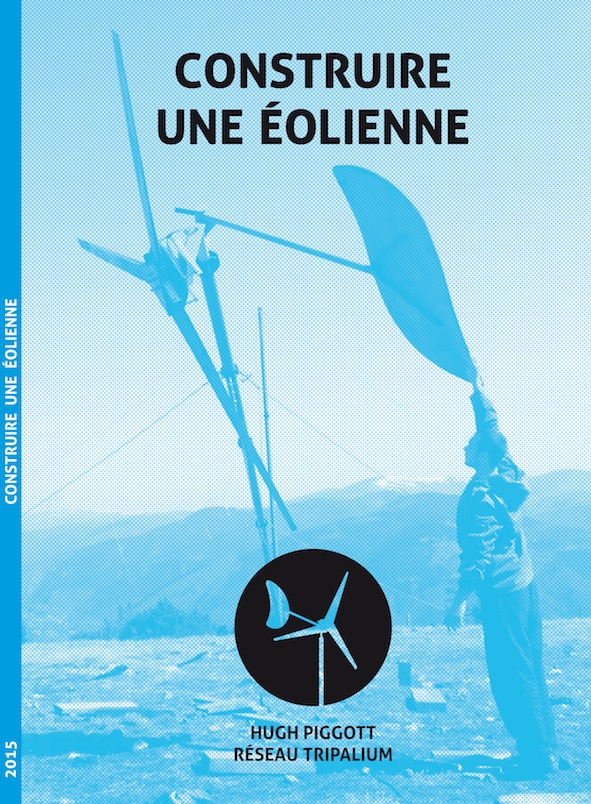
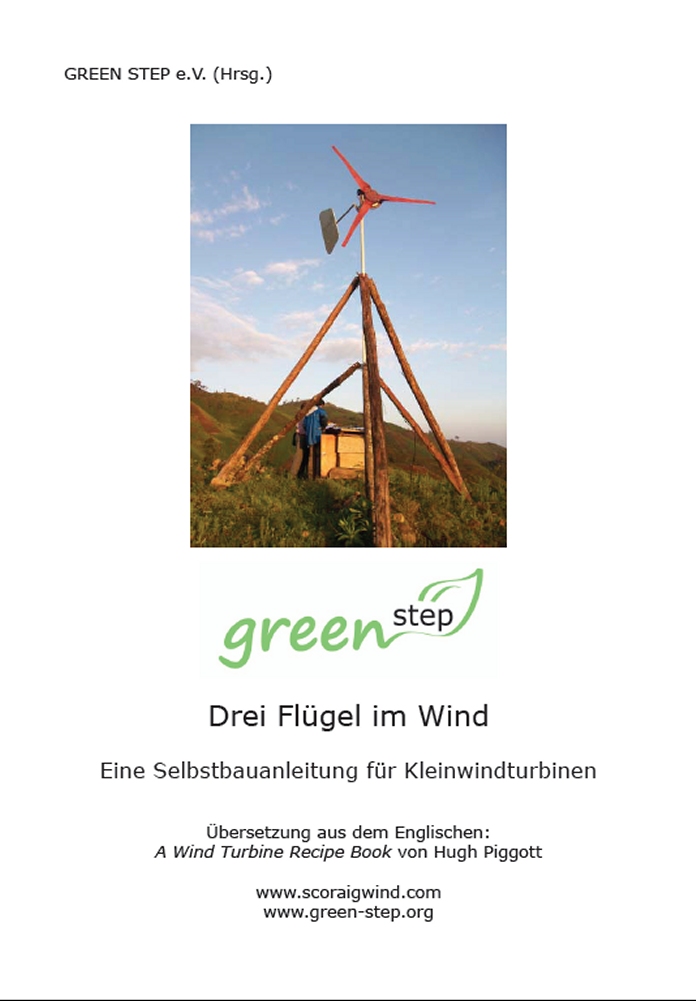
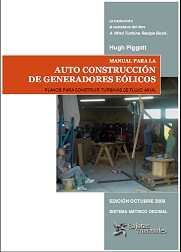


Bonjour, hello,
I’m struggling with the path of designing my WT,
Rather than starting with the WT itself, I rather started by deteriming the wind power (potential available) to about 30Nm torque
Now that I know what energy I’m dealing with, I just can’t find anywhere what this force will allow me to run (turn) as a PMA. Will it turn a 3m large, one magnet rotor, many magnets, and two external stators with as many coils (with IDK how many turns of IDK what gauge)
BAsed on my potentially available 30 Nm torque, how do I determine how many magnets (number, strength) and coils I can put ?
Any suggestion (book, etc..) will be greatly appreciated !
Éric
hi Eric,
It’s a strange place to start your design I think but if you can make 30 Nm torque at 300 rpm then this would be 1,000W mechanical power. You could use an alternator design from my recipes for this scenario. I would suggest the 2400 or the 3000 diameter turbine designs. These have 12 magnets and 9 coils. They can handle this torque.
My suggestion would be to read the Recipe book design notes on page 54 onward to see the process I use for designing a wind turbine. I do not find torque a useful parameter as such, although it is possible to calculate it from the speed and power that we know about.
cheers,
Hugh
Greetings from Ireland..
I would like to buy your recipe book, just wondering if it’s still possible to order from Austria ( paper edition) as the link no longer works.
Kind regards Chris
Pingback: Materials for my metric Wind Turbine Recipe Book designs | Hugh Piggott's blog
Pingback: Low cost NdFeB magnets | Hugh Piggott's blog
Hi All
I purchased a Jacobs 20kw. I am all ready to go except for one part.
I need the internal exciter winding for a Jacobs 20kw Generator. This winding is about the size of a dinner plate and about 2inches thick – have a look at the attached picture. Would you happen to know where I might get this part or would you know of anyone that might have the necessary equipment to re-wind this part, thanks?
I have exhausted a lot of avenues over the last week to find a replacement or repair, so any pointers would be really appreciated.
If you happen to have this part in an old machine, I would gladly purchase it from you and take care of the courier expenses.
I look forward to hearing from you.
With kind regards,
Seamus
Pingback: Windradworkshop in Reutlingen - ERNI e.V.
Hello Hugh,
I’ve just bought the 2F Construction Manual, really excited to read it! I was wondering if it is necessary to have read the Wind Turbine Cookbook before?
I also wanted to thank you for all the work you’ve done, it will help a lot of us out in the times to come.
All the best.
Denis
Oops rather a late reply to this one but no the 2F plans stand alone and you do not need to also buy the Recipe book to be successful with the 2F.
Hugh
Pingback: DIY Wind Turbine ready to go out into the world | The Fold
Hi Hugh. I was wondering how you were getting on with the ferrite magnet book. I remember you writing that you were working on a manuscript. I hope it will be out soon. I took part in an 2.4m turbine course in west cork with Miriam and Jimmy last year. At least I think it was last year. I’m losing track of time. Hope you and yours are all well.
Regards, Arthur Sheridan.
Hi Arthur,
Sorry I did not see this comment before. Anyway yes I did publish plans for a 2m diameter ferrite version which you can buy as hard copy or download as an ebook. YOu can see how to get these 2F plans on this page actually.
I have built some larger ferrite machines and am very pleased with them. I can send you pdf plans for 3m or 3.6 or 4m size and I have some ideas for 2.4m size too. It’s probably best you buy the 2F plans and the recipe book as background as these pdfs are sketchy supplements rather than full information. Let me know if you plan one of these projects and I will send you the pdf.
It’s not really worth my while to do a formal book publication thing as the sales are so low nowadays but I still like to help people and share my knowledge where it is useful. You can contact me best by email at [email protected].
cheers
Hugh
Hi Hugh,
What is the rough cost for building an 8 foot wind turbine? I only need an approximation in terms of hundreds/thousands of pounds.
hi
Roughly £600 or $800 sort of thing. A lot depends on how good ytou are at finding things for low cost. For example the wood for the blades and the wheel hub for the bearings. It helps a lot to buy in bulk, for example magnets disks are cheaper to cut in a batch of six than in a pair.
cheers
Hugh
Hey Hugh I read the french version. This is amazing. I was wondering what are your thoughts on using a 3d printer to print the turbine(replace the wood), with some strong filaments (not sure which one yet). I will keep the resin calc metal bits… and use wood or metal to build the tower.
Hi David,
I don’t have any thoughts as I don’t know how to use a 3D printer sorry. Yes I would suspect that the tensile strength would be an issue if printing with plastic blobs.
cheers
Hugh
Hi Hugh thank you! Did you hear about the new HET motor? This seems very promising for wind turbines too… https://www.youtube.com/watch?v=8gO60bt6rqk&feature=youtu.be
Yeah that looks pretty cool. Very similar to the ones in the Proven wind turbines actually. Toroidal designs can be very good for power/weight. Hence can be made for lower rpm. Hard to build but nice.
cheers
Hugh
Hi Hugh, can I order books in Romanian language? Thanks
Hi,
Quick question – based on some numbers I’ve done, I was curious about generating 115 VAC so I can have mains voltage available instead of having a battery bank. I’m putting my generator onto a water wheel on a swift moving river where I can have a constant and steady supply.
One calculation I cannot seem to find anywhere is determining how much current a generator makes based upon the construction (coil size, gauge, etc).
Can you point me in the right direction?
hi Bob,
You will have to match supply to demand and this is impossible with wind but doable with hydro. You would need a ballast load system to regulate load and speed and keep the turbine/wheel under constant steady load. You’d need to think about the frequency too.
As for current, this determines the torque on the alternator and it also creates losses in the wiring so it will affect the efficiency and the heating (limiting max output) and also the internal voltage drop that has to be factored into the design.
I have spreadsheets I use for all of this and I try to help people on a case by case basis when they provide enough data. My recipe book has a section about it at the end that may be worth reading on page 54.
cheers
Hugh
Hi Bob,
An alternative for Hydro systems is rather than use a permanent magnet alternator, drive a conventional 220V induction electric motor. The motor when it is driven past it’s faceplate motor speed about 10%, becomes a generator, that is locked in phase with the grid (as that’s where it’s exciting field comes from). This solves a lot of problems in grid integration and is failsafe for technicians working on the lines, as when the power goes out, this will loose it’s exciting field, and stop generation. Utilities will require that you have an “anti-islanding” device to ensure that 2 of these installed close together wouldn’t interact to keep generating, after a line failure.
This only works if your system has consistent rpm, so isn’t generally suitable for wind turbines.
There is a book that documents how it’s been done, and here’s a link to a good web discussion on how it doesn’t work so well for a wind turbine, but with links enough for you to find all you need about the electronics. https://www.fieldlines.com/index.php?topic=143554.0
Much cheaper than jumping through the hoops of rectifying the wild AC, to DC, and back AC, locked in phase with the grid (mains)
I built a few stand alone hydros using capacitor-excited induction motors and voltage regulators back in the 1990s. Nigel Smith has written an excellent guide that I followed.
However in most cases off-grid you can benefit from using battery storage, and this points toward a DC system. PM alternators can have a very good efficiency at low windspeeds and work at variable rpm so are ideal for off-grid wind turbines. They also work very well for hydro turbines as you can adjust the rpm (via the voltage or the field excitation) to match the requirements of the site, and charge batteries or feed the grid via solar inverters which are low cost and approved for grid connection. Connecting an induction motor to the grid as a generator is simple electrically, but complex to do safely as you need a rather rare relay that can be costly to approve.
Hello, I would like to buy the ebook spanish version. Is it available? I am from Argentina and would like to build an eolic generator.
Thanks a lot,
Miguel
hi Miguel,
In Argentina you can ask 500rpm.
They have the Spanish edition, and they also run courses. https://www.facebook.com/500RPM/
http://www.500rpm.org/
have fun
Hugh
Thanks a lot! I will check there!
Hi, Hugh, How are you,i live in Libya
iam happy to send this message to u ^_^
so i do all things and i stick into problem
here in Libya epoxy resin is to expensive and i can’t buy it
so i need any ideas to cast my stator and i’ll be happy to help if u could ^_^
big hi to u
god safe u
#E
hi there,
I never use epoxy to cast a stator. I use Vinyl Ester resin mostly, but Polyester resin is also fine for the stator. I have made many stators with polyester resin (fibreglass resin). It’s fine for stators. For the magnet rotor I prefer to use Vinyl ester but it’s OK to use polyester for that too.
Have fun. If you read my Recipe Book you will be OK.
cheers
Hugh
Hi, Hugh, How are you,i live in UAE, and using your recipe book that i bought last year i am very late to start my windmill project, because i am not belong to engg. field and now i am facing some problem in your book page no 37 (1) and 56 (1,2).
Page 37 (1) Turbine diameter 3000 mm at 48V : How you calculate Turns per coil 110. ?
per phase 3 coil so total 110 x 3=330 per phase is it right ?
Page 56 (1) What is the calculation for calculate the “B Tesla” and when i checked on online site “https://www.supermagnete.com/faq/flux” is not matching with your data, how you got this data 0.3, 0.44, 0.62 ?.
Page 56 (2) ” Total series turns n = (DC V + 1.4) x 11 / (A x Bx rpm) ” from where this “11” no figure came and whats about the “2.72” no figure.
sir do you have any Excel Sheet or any calculation software which you can share with me to easy my calculation.
hi Pankaj,
You can easily make a spreadsheet using the simple formulae that I have provided in the recipe book. You can check it against the results in the table on page 37.
110 turns is the correct number for a 3m diameter machine if you follow the recipe and connect a 48V battery. I don’t understand your problem. You do not need to calculate it, but I have shown you how, if you follow these equations.
B in the air gap will be approximately 0.62mT. Supermagnet.de are maybe telling you about Br which is much higher due to there not being any air gap but you cannot build an alternator like that. To get the maximum energy product form the magnets you must work with a B that is roughly 50% of Br.
If you read the text carefully then you will find out that the constant 11 is derived from various other constants such as 60 seconds in one minute and root 3 and peak/average voltage. 2.71 = 1.73 x 1.57 But you don’t need to understand it in order to use it. I had hoped I made it clear how it is derived, but I only had a couple of spare pages in the book, so maybe the explanation is too brief. Sorry. My printer can only do 64 pages in this binding format, and mostly I wanted to fit in the practical detail needed.
I hope that this answers your questions but if not then please ask again.
cheers
Hugh
Hi, Hugh, i live in Belize, and have attended a workshop on building wind turbine with Dan Bartman in the USA. I am working with a Menonite friend of mine to build one for electrification in his house using your recipe book that i bought earlier this year. Shypyard community is open and houses are quite distance between and windy for most of the time. will a 50 feet tower be ok or do you recommend higher tower. Also can it support three light bulbs and a refrigerator?
Hi Raul,
I mostly use forty foot towers here at Scoraig and they work pretty well although taller would be better.
The answer to the light bulb question is it depends. Three 100W bulbs left on all of the time, probably not. Three 5W LED bulbs used only in the evenings yes for sure. In between it depends on how big your turbine is and how windy it actually is. Fridges come in different sizes and of course it depends how hard they have to work, but most likely it will work some (or even most) of the time if the turbine is 8 foot or more in diameter. Sometimes if the wind stops maybe your battery will go flat so it’s good to have some PV panels and even a generator to charge them although you might not have to use it for months at a time.
My advice is try it and see. But only if you are confident that it’s a windy place. If you want to be scientific about it then figure out the kWh you use and check the table in my Recipe book page 4.
Have fun
Hugh
Hi friend, i am engineer (electrical) and a sailor, so I wonder if it is possible to bild a wind generator for my sailboat ( i think that 200/300w nominal power will be enough , but your opinion here is more reliable, of course) .
The idea is to charge batteries and have a back up sistem to the main generator or the solar panel.
I live in argentina but travel very often tu uruguay (sailing) and chile (car).
Hi
Yes of course it’s very possible if you have room on the sailboat for a large enough turbine to be useful. My recipe book describes a range of sizes. I have no idea how large your boat is so I can’t suggest a size for you.
cheers
Hugh
Hi , I sure could use a little advice! I bought a 3 kw AFPM coreless generator, on ebay, it is for a vawt, it has no stator made by TanChang N.E.T. in korea its about 16″ in diameter and has about 36 long tapered magnets on each rotor and claims no cogging, Do you by any chance know how to build a coreless stator, or know someone who might know, because I am lost , I read all I can get my hands on , I am crasy about vawts. Any help will be greatly appreciated, you just dont know.. Rick V> from Louisiana USA
Hi , I sure could use a little advice! I bought a 3 kw AFPM coreless generator, on ebay, it is for a vawt, it has no stator made by TanChang N.E.T. in korea its about 16″ in diameter and has about 36 long tapered magnets on each rotor and claims no cogging, Do you by any chance know how to build a coreless stator, or know someone who might know, because I am lost , I read all I can get my hands on , I am crasy about vawts. Any help will be greatly appreciated, you just dont know.. Rick V> from Louisiana USA
hi Ricky,
VAWTs are certainly crazy and I do not advise you to go crazy too but you can try if you like. I recommend you use a proper windmill to get good results.
Anyway the stator is no doubt doable but I would need a photo of the magnet rotors and an idea of the power/rpm details of the turbine and the battery voltage. Then I can advise for sure.
Most VAWT enthusiasts have no idea of the power it can produce at a given rpm unfortunately, but you might be an exception?
Hugh
Boa noite!gostaria de saber a possibilidade do sr.hugh pigoth vir ao Brasil especificamente no estado do RS dar um de seus cursos.
Atenciosamente:felipe aires
http://www.500rpm.org/
Dear Hugh,
I want to consult about the airfoils of the blades used in your design. In a thesis it is referred that the airfoil of your blades’ design is based on a standard airfoil NACA 4412. My question is if it is true or not, because the schematic view of the airfoil in your book has a flat face in its bottom. The upper face of the airfoil is an approximation to a NACA 4412 or not?
Regards from Argentina,
Ezequiel
Dear Hugh,
With those dimensions of 1x2x1/2 inch what should be the pulling force of the magnets?
What if you cannot get under n42 – 72lbs? What will happen when altering that parameter? More pulling force equals more volts?
Thank you so much, David
hi
I don’t use pulling force as a measure but I am sure it can be useful under controlled conditions. I mostly look at the “remanent flux density” Br. if the magnets are more powerful then you will get more voltage at lower speed. And vice versa.
If you want to adjust the flux density then you can do so by changing the air gap (gap between magnet faces). The minimum gap is determined by the stator and you will need some sensible clearance each side of it. But if you increase the gap you will get lower voltage at the same speed or higher speed to produce a given voltage.
I hope this helps.
Hugh
Dear Hugh Piggot
Desire has passed happy new year holidays
I ‘m Norman Sandoval from Nicaragua
Dear Engineer
I have a problem with building my turbine 1200 mm.
In the market I’ve only found neodymium magnets 3-1-1 / 2 pulgadas.No magnets seem to find the correct dimensions .
In the self-construction manual you recommend for this model magnets 46-30-10 mm or nearly 2-1-1 / 2 inches. ( Spanish version ) .
I need to know whether the turbine built with these magnets have an inch but if this will affect the performance of it .
Or failing that problem would build it with smaller magnets.
I would appreciate your help on the issue , since I am excited about the project .
Greetings and blessings from Nicaragua
Norman Sandoval
hi Norman,
If you are in Nicaragua then maybe you can get magnets from BlueEnergy there? http://www.blueenergygroup.org/ they used to build wind turbines. Or buy from texas here http://www.magnet4less.com/product_info.php?cPath=1_5&products_id=60
I think it will be very expensive to use 3 inch magnets and I would have to completely redesign the alternator for you so it’s not very practical.
Have fun
Hugh
good night hugh am Brazilian and I have seen quite your blog , I’d love to get your book in Portuguese